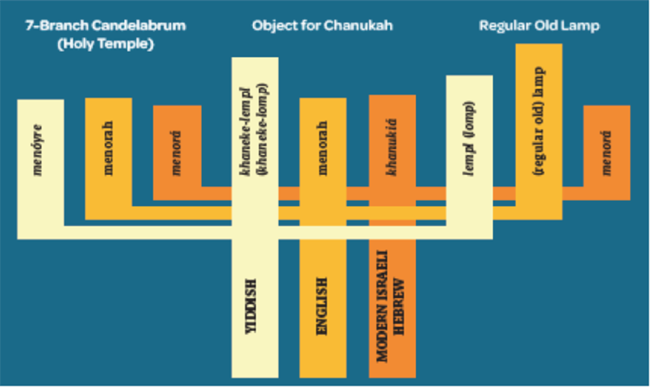
Chanukah, oy khaneke!
- Written by:
- Dovid Braun
- Published:
- Fall 2011 / 5772
- Part of issue number:
- 64

It turns out that a menorah—or menóyre, in Yiddish pronunciation—is not a Chanukah candelabrum. Not in Yiddish, at least. Nor in modern Israeli Hebrew.
In Yiddish, menóyre is the term for the biblical seven-branched candelabrum originally housed in the Holy Temple—or its likeness, as is often found decoratively in synagogues or as the emblem of the State of Israel.
In the Hebrew of present-day Israel, that is true too, and the pronunciation is slightly different from the Yiddish: menorá. But the word has a much more quotidian meaning in Hebrew, namely, ‘lamp.’ Yes, a basic electric lamp, for instance, is referred to as menorá. In fact, it doesn’t have to be basic, nor electric. It could also be a kerosene lamp, or it could be as elaborate and high-end as a Tiffany. In any event, there is no narrow association in modern Yiddish or Hebrew usage with this being a Chanukah object.
Indeed, the seven-branched candelabrum almost serves as a brand identifier for Jewish culture more generally. A case in point: a wide array of Yiddish books was published in Israel (and before that in post–World War II displaced persons camps) by Menoyre-farlag aka Farlag Menoyre (farlag meaning ‘publishing house’). The organization’s logo, aptly, had only the seven extensions and was in no way a reference to the Feast of Lights.
In what language, then, is menorah the term for the holder of the Chanukah candles? English! To be more exact, English and Ladino (the language of Sephardic Jewry). It is my hunch that this word in English, when associated with the Feast of Lights, is the contribution of Sephardim.
And what is the nine-branched ritual object used during Chanukah called in Yiddish? (Eight of the branches, by the way, symbolize the eight nights of Chanukah, and the separated ninth branch is used for the shames—the candle that lights the other candles.)
Unless the speaker is referring to a large ornamental piece, the term is kháneke-lempl. This literally means ‘Chanukah lamp.’ Lempl (‘lamp’) is a diminutive, that is, the form that indicates the object is of small to modest—hence typical—dimensions. If the lempl is unusually large, then it might be called a kháneke-lomp. (Lomp is the base form of the noun from which lempl is derived.) In various instances, Yiddish uses a diminutive not to indicate actual smallness but, instead, an item of everyday size which at times appears in larger form. Such is the case with hitl (‘hat,’ especially a hat with a visor worn by Jewish men and boys in Eastern Europe), bikhl (‘book’), zaytl (‘page’), bletl (‘page, handout, leaflet’), and knepl (‘button’)—all are diminutives. The nondiminutive forms (hut, bukh, zayt, blat, and knop) actually have an augmentative sense to them, connoting the relevant item in large format (e.g., bukh [‘ledger’], blat [‘folio; newspaper; oblong page of the Talmud’]).
The corresponding Modern Israeli Hebrew term, incidentally, is khanukiá. This word bears no hint of the meaning ‘lamp,’ nor any relation to menorah; it essentially means ‘Chanukah item, thing associated with Chanukah.’
Now, we hope you like the spelling we have chosen for Chanukah in the body of this article. If you don’t, there are many others in English that may make you happier—so many that the topic of how to spell the holiday’s name in English has become a motif of humor. But how is the Yiddish name of the holiday written when using the Latin alphabet, that is, in transliteration?
Fortunately, there is a system in place for presenting Yiddish to the English-reading eye, which is detailed in Uriel Weinreich’s indispensable Modern English-Yiddish Yiddish-English Dictionary and introductory grammar book College Yiddish. In both works, using the Latin alphabet, Weinreich spells out the Yiddish pronunciation of the holiday’s name in this way: khanike.
Yiddish spelling is generally considered to be based on a “phonetic system”—what you see is (more or less) what you pronounce. Broadly speaking, this is true, except for words of Semitic origin (that is: words that come from Hebrew or Aramaic). In such cases, the Yiddish spelling typically mimics that of the Hebrew or Aramaic. While this spelling in Yiddish proper may be difficult to figure out or memorize because it is not phonetic, transliteration into Latin letters has a user-friendly goal: to present the way the reader should pronounce the word, regardless of spelling in the original language.
In our instance, there’s an unstressed vowel in question: I have been writing about khaneke, while I quoted Weinreich’s authoritative works as recommending the spelling khanike. This vowel, when listened to carefully, is somewhere between what the symbols e and i represent in the phonetics of Yiddish.
That being said, I don’t really have a quarrel with Weinreich. Both spellings are accepted and acceptable. In the same way, I gladly would eat a latke. whether it’s made with potatoes and onions or potatoes alone. This is a rare instance in the standard Yiddish transliteration system when there are two justifiable spelling options. The system certainly does not suffer the chaos of English spelling—to my count, there are more English spellings of Chanukah than there are branches on the menorah—but it still cannot be held up as a poster child for providing a singular straightforward solution to every question of Yiddish romanization.
It almost seems as though the oy of the age-old Yiddish song "Khaneke, oy khaneke!"—that same song widely known in English translation (“Chanukah, oh Chanukah, come light the menorah”)—is on the one hand a shout of enthusiasm towards this joyous festival, and on the other a plaintive exclamation about spelling woes.
Nu, a freylekhn khaneke, or, if it’s your inclination, a freylekhn khanike!
Dovid (David) Braun is a linguist who has taught Yiddish language at the Yiddish Book Center, Harvard University, the University of Pennsylvania, Hebrew University, and the YIVO Institute for Jewish Research.
